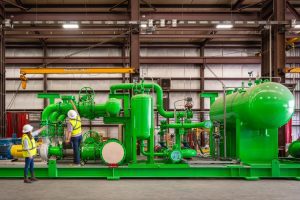The project will combine green hydrogen generated by Ohmium’s PEM electrolyzers with CO₂ captured from the Singareni Thermal Power Plant to produce green methanol. The process to synthesize green methanol from CO₂ emissions was developed by researchers at Breathe Applied Sciences and the Jawaharlal Nehru Centre for Advanced Scientific Research in India. Spirare Energy partnered with Ohmium to procure the PEM electrolyzer solution, an important component of the overall project.
Methanol is commonly used as a fuel or as a raw material in various industrial processes. Reducing or eliminating the carbon content of methanol production helps decrease greenhouse gas emissions and reduces reliance on fossil fuels. Technologies for converting CO₂ to green methanol can also help decarbonize various sectors, including the coal based thermal power sector.
“Converting CO₂ from coal based thermal power to green methanol can significantly advance decarbonization and sustainability,” said JNCASR Professor Sebastian Peter, Breathe Applied Sciences co-founder and project leader of the CO₂-to-green-methanol plant from JNCASR. “We are excited to see our research applied in this pioneering project and looking forward to seeing it scale.”
“Spirare is pleased to collaborate with JNCASR and Ohmium on this important project, which has great growth potential,” said Suhas Bhasin, CEO of Spirare Energy. “Ohmium is a trusted partner. We have worked with them previously and appreciate the efficiency and cost effectiveness of their product. Their hyper modular design helps streamline installation and scaling.”
Arne Ballantine, CEO of Ohmium International, said: “Ohmium is pleased to collaborate again with Spirare Energy, a leader in sustainable development projects in India. This is our second project together, and a very important one, as green methanol has the potential to significantly advance India’s energy independence and reduce carbon dioxide emissions. Building on our previous success, this follow-on project demonstrates our joint dedication to India’s energy future.”







